| State of Ohio Image Gallery |
|---|
| studenthandouts.com ↣ Geography ↣ Northern America ↣ USA ↣ American Midwest ↣ Ohio |
 State flag for Ohio. Ohio is the only state with a five-sided flag.
State flag for Ohio. Ohio is the only state with a five-sided flag.
When Ohio was opened to European-American settlement, it was covered with luxuriant vegetation. Many of the trees were hardwood, including oaks, maples, poplars, and magnolias. Hickories, chestnuts, butternuts, elms, beeches, cherries, locusts, and ash abounded. Huge sycamores thrived in the fertile river valleys. The flowering dogwood imparted beauty to the woods. The beautiful buckeye, which gave its name to the state, flourished in the river bottoms. Numerous species of wild grape covered the tops of the highest trees. Amidst the forest, in open glades and in swamps, other forms of vegetation grew in profusion. 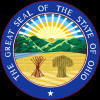 The Great Seal of the State of Ohio.
The Great Seal of the State of Ohio.
In clearing the land for the plow, most of the forests were destroyed. Those that remained were of great value in wood manufacturing. Among the animals found by the settlers in Ohio were deer, buffaloes, bears, wolves, panthers, foxes, squirrels, opossums, and raccoons. The streams abounded in beavers, minks, otters, and muskrats. Overhead flew clouds of wild pigeons, and through the woods stalked wild turkeys. Then, as now, many birds filled the forests with their song. Fish abounded in the streams and lakes. Since European-Americans first went into this territory, then known as a wilderness, the abode of the Native Americans, most of the wild animals, and many of the birds have been killed or driven away, while the waters yield fewer fish than in years gone by.  Map showing the position of Ohio within the United States of America.
Map showing the position of Ohio within the United States of America.
The chief European-American settlements of Ohio were five in number. (1) The oldest was at Marietta, and the settlers were chiefly from Massachusetts and other parts of New England. (2) The next was upon the site of Cincinnati, and these people came mostly from New Jersey. (3) The third was in the territory known as the "Virginia Military District," at Chillicothe, and was made chiefly by Virginians. (4) Pennsylvanians, embracing some Quakers and people of German descent (known as the Pennsylvania Dutch not because they were Dutch, but because they spoke Deutsch), made the fourth settlement in what was called the "Seven Ranges." (5) The fifth principal settlement was on the "Western Reserve," and the settlers came mostly from Connecticut. These hardy pioneers had been variously trained in political and religious matters, but they had all received a common discipline in habits of self-reliance and self-government.  The docks at Cleveland, Ohio, in 1895.
The docks at Cleveland, Ohio, in 1895.
Cleveland, situated on Lake Erie at the mouth of the Cuyahoga River, had remarkable growth in the late 19th century during the American Industrial Revolution. Its population increased from about 17,000 in 1850 to over 261,000 in 1890. The manufacturing interests of Cleveland were very large. They embraced many industries connected with iron and steel, the refining of oil, shipbuilding, and manufactures of wood. The city is centrally located with regard to coal and iron ore, within easy reach of the regions supplying fuel and raw materials. The city became one of the great centers of U.S. iron and steel manufacturing by the early 20th century.  Fountain Square and the Ohio River at Cincinnati, Ohio, in 1895.
Fountain Square and the Ohio River at Cincinnati, Ohio, in 1895.
Cincinnati has an excellent location for business and residential purposes. It is situated on the Ohio River, and has many miles of waterfront. Cincinnati is noted for its beautiful suburbs, the attention given to the cultivation of fine arts, its system of parks, its drives, and its educational facilities. It has long been regarded as one of the best-built cities in the United States. Toledo, on a fine harbor with many miles of dock, is a shipping point for vast quantities of grain, coal, iron ore, lumber, and staves. Several railroads, and the intersection of Interstates 75 and 80/90, give Toledo great advantages as a center of commerce. Several manufacturing plants are located in Toledo, including Libbey Glass and Jeep (part of Daimler-Chrysler). In the 20th century, Toledo was nicknamed the "glass capital of the world." Edward Drummond Libbey, owner of Libbey Glass, donated the funds to build the Toledo Museum of Art (1901), perpetually ranked as one of the world's top museums. The postmodern Glass Pavilion, located directly across the street from the main museum building, and which holds one of the world's largest and most renowned glass collections, won the 2007 Design Award for "Best Museum" by Travel and Leisure. Additionally, the Center for the Visual Arts (the Toledo Museum of Art campus for the University of Toledo's fine arts program), built in 1992, was designed by architect Frank O. Gehry. 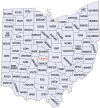 Map showing the 88 counties of Ohio.
Map showing the 88 counties of Ohio.
Columbus, the capital city of Ohio, is the seat of the Ohio State University, and of many of the chief state institutions. It is a very wealthy city, with large manufacturing industries, and is a great center of coal, iron, and lumber interests. It is located in the midst of a country unsurpassed for agricultural purposes. 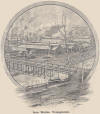 Ironworks at Youngstown, Ohio, in 1895.
Ironworks at Youngstown, Ohio, in 1895.
|
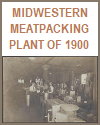 | ||||||||||
| Folger Meatpacking Plant in Toledo, Ohio, circa 1900 |
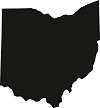 |  |  | 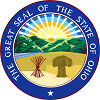 | |||||||
| JPG PNG SVG | JPG PNG SVG | JPG PNG SVG | JPG PNG SVG |
 |  | 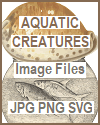 |  |  |
| studenthandouts.com ↣ Geography ↣ Northern America ↣ USA ↣ American Midwest ↣ Ohio |








